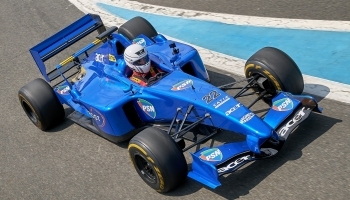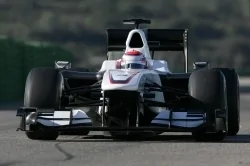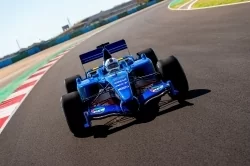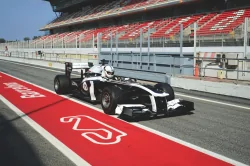🏎️ Williams FW32 — 2010 Season
The Williams FW32 marked the return of Cosworth as an engine supplier to Formula 1, embodying a balance of reliability, performance, and compliance with the 2010 technical regulations.
Designed and developed at the team’s Grove headquarters, the FW32 was driven by Rubens Barrichello and Nico Hülkenberg throughout the 2010 Formula 1 World Championship.
⚙️ Chassis
-
Construction: Carbon fibre and epoxy monocoque with composite honeycomb structure, exceeding FIA crash and rigidity requirements.
-
Front Suspension: Double wishbones in carbon fibre, pushrod-activated springs and anti-roll bar.
-
Rear Suspension: Double wishbones with pushrod-activated springs and anti-roll bar.
-
Dampers: Williams F1.
-
Steering: Williams F1 rack-and-pinion, power-assisted.
-
Brakes: Six-piston calipers all round, carbon discs and pads.
-
Wheels: Forged magnesium RAYS.
-
Fuel System: Kevlar-reinforced rubber fuel cell.
-
Cooling System: Aluminium radiators for water, oil, and gearbox.
-
Electronics: FIA-standard ECU.
-
Cockpit:
-
Anatomically shaped removable carbon-fibre seat trimmed in Alcantara.
-
Six-point safety harness with 75 mm shoulder straps.
-
HANS device.
-
-
Overall width: 1,800 mm.
🔧 Transmission
-
Gearbox: Williams F1 seven-speed sequential semi-automatic with reverse.
-
Gear selection: Electro-hydraulic, seamless-shift system.
-
Clutch: Carbon multi-plate.
🏁 Engine
-
Designation: Cosworth CA2010.
-
Configuration: 2.4-litre 90° V8.
-
Power output: Approx. 750 hp at 18,000 rpm.
-
Valve train: Pneumatic.
-
Electronics: Cosworth fuel and ignition management systems.
-
Materials:
-
Aluminium block and pistons.
-
Billet steel crankshaft.
-
Titanium connecting rods.
-
⚡ Highlights
-
Marked Cosworth’s return to Formula 1 after a three-year absence.
-
Scored points at the opening race of the 2010 season (Bahrain Grand Prix).
-
Nico Hülkenberg claimed a spectacular pole position at the Brazilian Grand Prix, showcasing the FW32’s potential in wet conditions.















